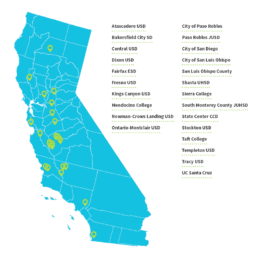Hear from ForeFront Power’s Project Development team to learn about what happens after a solar and energy storage contract is signed.
There are many steps that a ForeFront Power takes to ensure that a school’s solar and storage project adheres to local regulations, integrates seamlessly into your campus, and meets the requirements of financiers.
Webinar Preview: Solar Development 201 – From Solar Development 201: From Construction to Commissioning
Join ForeFront Power’s Project Development team for Part II of our Solar Development Webinar Series for a comprehensive overview of what to expect after a solar and energy storage contract is signed.
Undergoing a solar and storage project is a major endeavor for any school district; but arguably one of the most beneficial. Making the choice to adopt clean, cheaper renewable energy is something to celebrate! However, once the dotted line is signed and development goes underway, what is to be expected out of the whole process? What will a solar developer do to ensure that a school’s solar and storage project adheres to local regulations, integrates seamlessly into your campus, and meets the requirements of financiers.
In our upcoming webinar on Tuesday, January 28, tenured solar project managers will provide a comprehensive overview of everything that facilities and operations managers can expect once construction of a solar project moves forward, including:
- Phasing and Sequencing
- Material Staging
- Array Installation
- DSA Inspections and Approvals
- Punchlist Items and Closeout
The Solar Development Process
In Part I of this webinar series we introduced the typical project development process and timeline. We covered site diligence, permitting, interconnection, design and procurement. Part II will describe the steps, processes, and the workflow that takes place during the execution and implementation portion of the project, up through closeout.
Here is a brief overview of the primary phases and what facilities and operations managers should expect through each step in the process.
Step 1: Pre-Construction Planning
Similar to the development kick-off call, successful project execution requires careful planning and constant communication. Once near permit submission, the agenda switches to construction topics. These include
- Phasing and sequencing
- Temporary constructs
- Schedule adjustments
- Other checklist items
Step 2: Construction
Once construction begins, the following actions will occur:
- Site Modification
- Material Staging
- LED Lighting
- Array Assembly
- Battery Energy Storage System (BESS)
- Installation of data acquisition system (DAS) equipment
- Installation of utility upgrades, (where applicable
- Full Site Cleanup
Step 3: Start-up, Operation and Commissioning
Start-up, operation and commissioning are the phases that follow mechanical completion. Mechanical Completion is achieved once construction concluded and DSA has completed and verified all inspections
Following Mechanical Completion and DSA approval, the following steps will occur:
- Start-up
- Request for Permission to Operate (PTO)
- System Commissioning and Performance
- Notice of Commercial Operation:
Step 4: Closeout
Closeout refers to the part of the development process that takes place once mechanical construction is completed and final modifications and/or administrative paperwork are underway. These items are organized into a “Punchlist” and/or “Closing Checklist”, which are often noted and recorded during the construction phase and up upon achieving Mechanical Completion. The following are some of the items that are included in the Punchlist and after:
- Punchlist items:
- Closeout Documentation
- Hand off to Asset Management: System Safety Training
- Live Demonstration of the Data Acquisition software system Final Site Clean-Up
Speakers Include:
- Nate Roberts: Sr. Director, Development
- Casey Miller: Director, Development
- David Granlund: Sr. Project Manager, Development

Who is ForeFront Power?
ForeFront Power is a leading solar energy provider to schools around the country. We provide school districts with the maximum potential savings from solar available on the market today though a power purchase agreement (PPA), while providing the highest quality installation with the least risk.
With over 400 megawatts (MW) of operational projects with schools, our team has the capability to transform your district’s solar installations beyond just energy production and savings.
Partnership with SPURR
The School Project for Utility Rate Reduction (SPURR) is a joint powers authority dedicated to helping California schools and colleges control and reduce utility expenses. Our group is the proud winner of SPURR’s Renewable Energy Aggregated Procurement (REAP) Program competitive RFP that allows schools, colleges, and public agencies in California save time and money on their procurement and energy costs. The REAP Program provides pre-negotiated contracts, industry leading pricing, and standardized terms.
Interested in learning more?
We would love to discuss how our solutions might be a fit for your organization. Contact one of our solar, storage, or e-mobility experts today:

